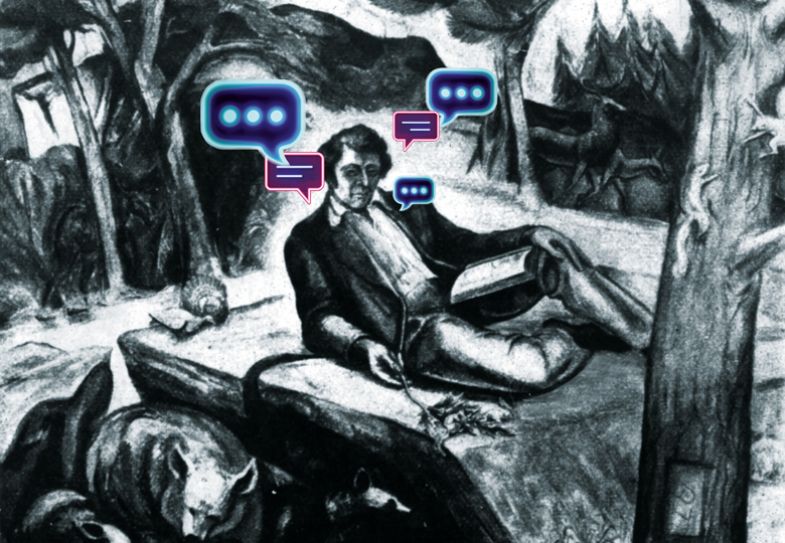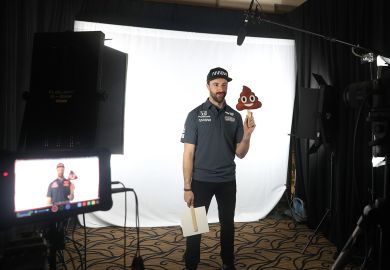When I was a kid, I hated reading. I forced my eyes across the page, but the sentences never came to life for me – at least, not until eighth grade, when my mom, an English substitute teacher (a five-foot battleaxe of a woman), found a report card buried in my bookbag. I won’t tell you what my grades in reading and writing were, but they were not the marks my mother expected.
“You are going to do your reading with me,” she said, pausing to compose herself. “From now on.”
And that’s what happened. Evening after evening, we sat down after dinner at the kitchen table and we read together. This was not story time or a chance to listen to reading that I should have been doing myself, but rather my first experience of being led through challenging books – Machiavelli’s The Prince, Salinger’s The Catcher in the Rye, Plato’s Republic – with an expert guide. Every few pages, Mom would stop me and ask me questions that challenged my thinking about the text, drew me deeper into its themes and created a space to ask my own questions about the author, the text and its place in the history of literature. And this is how I came to love reading – and came to be a writer and a philosophy professor.
Most students don’t have mothers like mine. I know how lucky I was. And I know that many of my students hate reading. I try my best to stand in, but my mid-sized state university is not Oxford: the one-to-one tutorial style is not possible at institutions such as mine, which depend on tuition fees and large classes. But recently, in a conversation with a member of the board at the Boston Museum of Fine Arts, we got to talking about artificial intelligence and ways it might make museums, and those little placards next to paintings, really dynamic, even interactive. I thought about the wildly successful “Hello Vincent” chatbot at Musée d’Orsay. And then, because I’m a reader and a teacher of classic literature, I thought about books.
Artificial intelligence is about to do for reading what museums are already using it to do in their exhibits. We are entering a new age of the book, as revolutionary as the invention of the Gutenberg press. As I write this, readers already have the power to ask books questions, and the books can answer back.
When ChatGPT took the world by storm in November 2022, my students were the quickest studies. They liked ChatGPT (a lot). David Smith, a Sheffield Hallam University professor of bioscience education, summarised it well: “[Students] don’t want it to be vilified. They want to be taught how to use it.”
But here’s the interesting thing: for students who use it not to produce zombie papers but to produce simulated conversations, the best evidence suggests it heightens their awareness, curiosity and interest, rather than stifling it.
When I asked my own students to generate texts that included active conversations about their chosen subject with a chatbot, and to submit those conversations as drafts along with their own finished papers, I found that many of them were producing much more engaged and sophisticated work than they had ever previously crafted – and, more importantly, they were excited about it. They enjoyed the process of writing the piece. A recent study at the Massachusetts Institute of Technology confirms my anecdotal experience: when students were engaging with a chatbot as part of producing their work – when they were using it as one of many tools in the toolbox for producing original writing – they learned faster, better and with greater satisfaction.

What if AI-enabled chat windows could be embedded in a text and offer a site of conversation about it in real time with someone as smart as my mom? What if one of the classics of literature or philosophy were available with an expert commentary provided by someone who had spent years studying that text and which was directly sourced by the artificial intelligence acting as the reader’s interlocutor? In this way, the Socratic tutorial method – adopted not just by my mother but by almost every great thinker in history – used could be employed to create a conversation about the book. It could generate the same excitement and enhanced learning of a classic text that we have found our students demonstrating when creatively interacting with a chatbot.
Teaming up with researchers based out of Boston, California and Ukraine, I have now dictated 30 hours of answers to nearly 1,200 questions about Henry David Thoreau’s experimental memoir Walden. I’ve also asked another 1,000 questions that might interest readers about the text. When this material serves as the context window for a chatbot about the text, a reader can ask almost anything and get an answer that is surprisingly like my own, and get follow-up questions that I have crafted to give them an unexpected and meaningful deep dive in Walden.
In tests, the conversations about the books that we are working with are quickly proving to be more dynamic than I could have imagined. If a large language model (LLM) can be trained on literature written by an engaging scholar, it also means that an LLM can help bring literature to life for countless readers who might otherwise not find their way to those books.
The experience of dictating into the void about Walden was often tedious: just me talking into my recorder, trying to think up every question my students had asked about it over the years. Then it struck me that being interviewed about the book might make the whole experience of being turned into a chatbot not only pleasant but meaningful and, perhaps most importantly (this is why we love the classroom), dynamic, exciting, fun. So at the end of my Walden experiment, I enlisted a friend, educator and Thoreau expert, Michael Goodwin, to ask me any last questions about Thoreau’s classic.
I was right: Michael, playing the inquisitive student, drew out the most personal and revealing material – insights I didn’t even know I had, much less would have expressed to myself – and a key idea was hatched in this new age of AI-reading: if AI platforms use real conversations, about meaningful subjects, as their training ground, it is more likely that users will be able to employ AI platforms to have rich, simulated conversations about meaningful subjects. I tested this hypothesis in the spring by interviewing the Booker prizewinner John Banville about James Joyce’s Dubliners, and the results were remarkable. The conversations in the e-reader sounded like, and reacted like, the conversations between Banville and myself.
Would it pass the Turing test and sound like an actual human? Maybe, maybe not – it depended on the questions you asked. (If you treated it like a human, it sounded uncannily authentic, but if you tried to trick it, you could still do so.) Either way, it was in an entirely different class from the cardboard-boxed answers of ChatGPT. No one is going to want to talk to ChatGPT about great books, but people care a great deal about the opinions of people they respect about the classics. Trust me, generative AI will become a tool to deliver readers to authors’ authentic insights and perspectives in unexpected ways.
Yes, I have an agenda: I would like everyone to love reading in the way that I now do, and I would like all of us to use AI in ways that aren’t meaningless, disappointing or just plain gross. In my heart, like my mother, I am a teacher, and I believe that this is (forgive the phrase) one of the great teachable moments of our time. It’s also one of those rare times – as with the invention of the internet itself – that knowledge can be democratised in a radical way for the better of all.
Before Johannes Gutenberg’s invention of movable type in 1440, the written word had been entombed in handwritten manuscripts, read by the chosen few. By the 17th century, literacy rates had spiked and the proliferation of the written word had begun. Nevertheless, many of the hardest yet most rewarding texts – classics such as Joyce’s Ulysses and Plato’s Republic – remained inaccessible, incomprehensible, given that understanding them typically involved careful study with a talented teacher. And those teachers are available to the select few.
The inherent elitism of a certain kind of education hasn’t really changed over the years – until now. We will very soon – wait, even now, it’s happening – be able to scale simulated, interactive conversations about an enormous variety of classic works from every literary, scientific, philosophical and spiritual tradition. The birth of LLMs, and their potential integration into the process of close reading, will revive and enliven moribund words, ancient points of view, even dead languages. Yesterday, I used AI to translate a text from Sanskrit and PalI to Tibetan to Koine to Sumerian. Amazed and delighted, I was DMing about it with a friend from Mexico, who wrote back and asked me: “What about Nahuatl?” (The language of the Aztecs.) I learned that the Sanskrit term for enlightened mind (“bodhi”) in ancient Aztec is “Tlamatiliztli”.
What I see happening – in months, not years – is the advent of convenient in-reading tools to help students break comprehension roadblocks. The commentary I am giving on Walden (I like to think of it as a “rebinding”) is founded on a deep belief that reading is a personal and interpretive experience. Commentators who develop this new type of interactive book can model and inspire the kind of personal close reading behaviour we want students to learn – and then AI will be used to amplify and scale the message of these teachers.
Will “real life” teachers be replaced by AI? No. Students spend most of their time reading their assigned books outside class, not in the classroom itself. Should they be using AI to have a better and deeper reading experience outside the classroom? Well, of course! The more equipped students are to discuss the text, the more everyone learns. I suspect that teachers will find they don’t have to spend nearly as much time covering the basics, allowing discussions to reach much higher levels of engagement, both much more frequently and with many more students.
Teachers, too, will employ AI-enhanced reading experiences, so that they are as prepared as possible for the magic of flesh-and-blood group discussions. Almost 20 years ago, I was asked to teach Walden for the first time. What I would have given for a little help: for the chance to ask a seasoned teacher how they did it. So these interactive books will not serve students alone. The academic world will soon wake up to the fact that LLMs are a general-purpose technology (akin to the electric motor). There are all sorts of creative and authentic ways to make use of them that we’re only beginning to explore.
In closing, let me say a word about the ongoing lawsuit brought by a variety of leading writers and other intellectuals against OpenAI. One thing is clear: this case is not akin to Napster or Spotify threatening to steal content from the music industry. OpenAI is not corpus-snatching for the sake of reselling books.
The fact that it is using works of literature to train its LLMs should give us pause, and these copyright issues are sensible ones. But rather than just worrying about who owns what, let’s think big picture for a moment. What does the incorporation of the knowledge of the world into LLMs really mean, for us? It means that you will, in the very near future, be able to talk to the books that you read. And it is up to teachers like us to get ahead of these technological trends, and if not safeguard, at least provide helpful expertise for our students in their inevitable conversations in a virtual world.
Socrates warned that the written word is dangerous – just like paintings – because they can’t talk back or answer for themselves. But now they can. And, with care, they can do so in the very way Socrates recommended for seeking the truth.
John Kaag created Thoreau’s Walden for Rebind, an e-reading platform that will be launched in August. He is also the co-founder of the company. He is Donahue professor of the arts at University of Massachusetts Lowell and external professor at the Santa Fe Institute.
Register to continue
Why register?
- Registration is free and only takes a moment
- Once registered, you can read 3 articles a month
- Sign up for our newsletter
Subscribe
Or subscribe for unlimited access to:
- Unlimited access to news, views, insights & reviews
- Digital editions
- Digital access to THE’s university and college rankings analysis
Already registered or a current subscriber?








